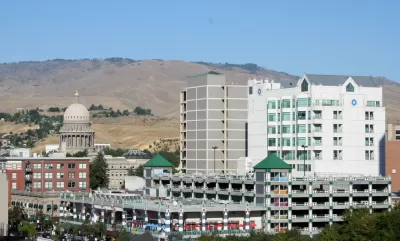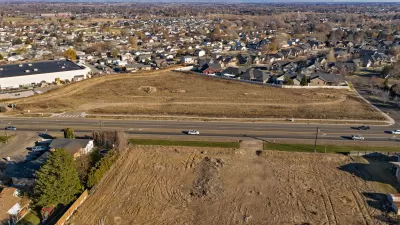The influx of new workers and residents in Downtown Boise has lead to a parking crunch, raising parking rates and leaving city officials searching for alternative solutions.

The shortage of parking in Downtown Boise is what the Idaho Statesman describes as a "good problem." The development boom, following the recession of 2008, has lead to an uptick in new workers that has so far overwhelmed the available downtown parking garages, creating an increase in parking rates and forcing workers to walk an extra few blocks from their parking space to their office. Sven Berg reports that Capital City Development Corporation (CCDC), whose goal is to spur urban renewal in the downtown area, has invested in acquiring spaces in parking garages to increase the supply for downtown businesses. However, the construction of new garages to meet the increased demand may be a ways off given the high costs to build new facilities.
In response, CCDC and city officials are focusing on freeing up parking by getting people out of their cars and into transit or onto bikes.
People who do business Downtown, as well those who plan its future, say the best answer lies in a quiver of partial solutions. Besides more car slots, they say, Downtown Boise needs to offer better alternatives to driving.
In the short term, that means adding park-and-ride systems. One initiative is already underway.
Berg reports that longer term solutions may focus on an improved bicycle network, and more buses. He notes that Boiseans, who have argued over transit for years, may have to "bite the bullet" on a light-rail system that currently has a $111 million price tag.
FULL STORY: Growing pains: Boise looks for answers as Downtown parking tightens

Maui's Vacation Rental Debate Turns Ugly
Verbal attacks, misinformation campaigns and fistfights plague a high-stakes debate to convert thousands of vacation rentals into long-term housing.

Planetizen Federal Action Tracker
A weekly monitor of how Trump’s orders and actions are impacting planners and planning in America.

In Urban Planning, AI Prompting Could be the New Design Thinking
Creativity has long been key to great urban design. What if we see AI as our new creative partner?

Chicago’s Ghost Rails
Just beneath the surface of the modern city lie the remnants of its expansive early 20th-century streetcar system.

Baker Creek Pavilion: Blending Nature and Architecture in Knoxville
Knoxville’s urban wilderness planning initiative unveils the "Baker Creek Pavilion" to increase the city's access to green spaces.

Pedestrian Deaths Drop, Remain Twice as High as in 2009
Fatalities declined by 4 percent in 2024, but the U.S. is still nowhere close to ‘Vision Zero.’
Urban Design for Planners 1: Software Tools
This six-course series explores essential urban design concepts using open source software and equips planners with the tools they need to participate fully in the urban design process.
Planning for Universal Design
Learn the tools for implementing Universal Design in planning regulations.
planning NEXT
Appalachian Highlands Housing Partners
Mpact (founded as Rail~Volution)
City of Camden Redevelopment Agency
City of Astoria
City of Portland
City of Laramie





























